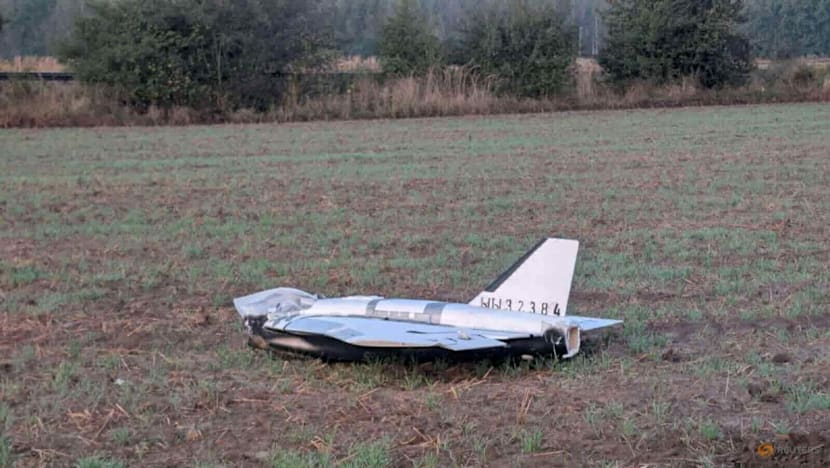Commentary: Russian drones over Poland were a test. Did NATO pass?
There is a real danger of the Ukraine war spilling over into NATO territory, says international security professor Stefan Wolff.

A damaged drone on the ground after falling in the eastern Polish village of Czosnowka, in this picture obtained from social media, on Sep 10, 2025. (File photo: Dariusz Stefaniuk via Reuters)

This audio is generated by an AI tool.
BIRMINGHAM: It is not the first time that Polish airspace has been violated by Russia since its invasion of Ukraine. But early in the morning of Wednesday (Sep 10), after Poland shot down Russian drones in its airspace, it became the first time a North Atlantic Treaty Organization (NATO) member opened fire during this war.
Regardless of whether it was intended or accidental, the drone incursions are a serious escalation of the Russian war against Ukraine.
There is a real danger of the conflict spilling over into NATO territory and a potential direct confrontation with Russia.
The Russian drones forced the temporary closure of several Polish airports, including the main hub in the capital Warsaw and a regional airport in eastern Poland that is a critical hub for deliveries of Western aid to Ukraine. This and the fact that a significant number of drones were involved – Poland reported 19 breaches – and that they only entered Poland – but not Slovakia or Hungary next door – makes it less likely that this was just an accident.
Earlier airspace violations could have been dismissed as drones or missiles simply going astray. In August, a Russian drone crashed in eastern Poland, and on earlier occasions, missiles entered Polish airspace before hitting targets in Ukraine. Russian drones have also previously crashed in countries on Ukraine’s western border: Moldova, which has ambitions to join the European Union, and EU and NATO member Romania.
So far, Ukraine and its European allies have strongly condemned Russian actions as a deliberate escalation. Poland has invoked NATO Article 4 to formally open consultations among the allies when any of them is threatened.
PART OF RUSSIA’S PLAN?
This latest transgression looks more like an actual act of aggression and a concerted test of Western responses.
Consider the timing: Russia’s latest provocation comes just after last week's high-profile meetings in China. First, the annual summit of the Shanghai Cooperation Organisation, which provided an ideal platform for Russian President Vladimir Putin to demonstrate to Ukraine and the West that he retains the strong support of two key partners – China and India.
Mr Putin then stayed on for bilateral meetings with senior Chinese officials, including his counterpart Xi Jinping. Among other things, these resulted, after many years of protracted negotiations, in the conclusion of an agreement to build the Power of Siberia 2 pipeline which, if completed and reaching full capacity, will provide a long-term perspective for Russian hydrocarbon exports to China.
Finally, during the military parade celebrating China’s defeat of Japan in World War II, the closer relationship between Russia, China and North Korea was on full display.
All of this is likely to have been interpreted in the Kremlin as a significant strengthening of the Russian position in general and in relation to its war against Ukraine. Its key partners are unlikely to make an outright condemnation of Russia’s reckless escalatory actions, and even less likely to put any pressure on Mr Putin to bring this war to an end.
RISK OF INADVERTENT ESCALATION
Importantly, the latest Russian provocation also happened just before the start of the Zapad-2025 military exercises in Belarus. Although these are regular joint drills of Russian and Belarusian forces, they have taken on additional significance since the full-scale Russian invasion of Ukraine in February 2022.
Poland has already announced that it will close its border with Belarus for the duration of the exercises, while Lithuania will block off part of its airspace. In addition, Poland will host the Iron Defender-25 military exercises, framed as a direct response to the Russian and Belarusian Zapad-2025 exercises.
The potential for inadvertent escalation into actual hostilities between Russia and NATO is now even higher.
This does not bring Europe to the brink of war, but as the Polish Prime Minister Donald Tusk noted, the continent is now the closest ever since the end of World War II to a major military confrontation between Russia and the West.
DID THE WEST PASS THE TEST?
The Western response overall does not instil much confidence. There are serious questions about NATO’s preparedness: Fighter jets were scrambled to shoot down the drones, and not all of the 19 drones were actually downed by them.
If NATO countries struggle to deal with such a small number of incursions, how, one might wonder, would they be able to cope with the kinds of attacks that involve hundreds of drones as well as missiles – something which Ukraine has experienced every night for months?
Beyond full-throated condemnation from Western capitals and talk of more sanctions and the creation of an air defence wall along NATO’s borders with Russia, the subsequent political and diplomatic response has also been underwhelming.
This will give Russia a sense of what the Kremlin can get away with, and if Mr Putin was yet again testing those boundaries, he has not yet run into a brick wall.
It will ultimately come down to Donald Trump, the American president. He has prevaricated for months over putting any real pressure on Mr Putin to end the war in Ukraine. What little excuse he has left not to get tough on Russia keeps running out.
If Mr Trump fails again to step up to the challenge that Mr Putin poses, Europe needs to brace itself for further escalation along its borders.
Stefan Wolff is Professor of International Security at the University of Birmingham and Head of the Department of Political Science and International Studies.


















